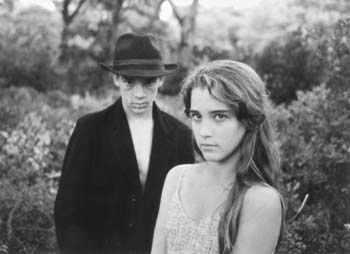Vahina, Vahina
'Marie Baie des Anges' is a searing exposé of Vespa gangs on the French Riviera and a Gypsy girl who could not be tamed
ANGEL OR SHARK? Fourteen-year-old Marie in Marie Baie des Anges is both, or so director Manuel Pradal would have us believe. The Baie des Anges, on the French Riviera, gets its name from a since-extinct Mediterranean shark. There's a legend about the fish, retold by a tour boat operator. An angel fell in love with a shark, and "their love made them both angel and shark." I didn't say it was an enlightening legend.
An island that looks roughly like a pair of dorsal fins juts out of the sea. The latter part of the movie takes place there--a new version of The Blue Lagoon. Gypsy girl Marie (Vahina Giocante) and her student thug of a boyfriend, Orso (Frédéric Malgras), live on fruit, trysts and drink. It's an idyll bordered by violence. Because the narrative is told with jump cuts and elisions, the audience must piece together the story in its imagination. There are soccer squabbles, rape or at least near-rape, and ultimately a pointless, random killing that brings down the curtain and leaves you in a numb, existential funk.
Like Kids, the movie shows us no-future young people seeking sensation. But they don't really enjoy it, as if they'd been partying for decades. Maybe transplanting the Kids story to foreign shores absolves an American audience. After all, we can't be held responsible for French society falling apart, can we? Oh yes, we can; the men sexually exploiting Marie are U.S. Marines stationed near the French coast. They appear to have trust funds, these Marines, because they can afford top-floor rooms at Riviera hotels. They have their own cars--and guns that they keep in the glove compartment; when Marie gets bored, she takes a gun out and dandles it, looking down the barrel and fanning it at the sky. At this point, halfway through, you can tell where the movie is headed.
There's sentiment in the story of Orso, the poor juvenile delinquent who can't provide for Marie as lavishly as her sugar daddies can. And this motif aligns with the social shame of letting these kids run wild. Both of these elements knock the movie out of the realm of strict gateau de fromage (cheesecake), although the lingering shots of Giocante tumbling underwater in her white bathing suit recall a line of Groucho Marx's Capt. Spaulding: "We took some pictures of the native girls, but they haven't developed yet." Marie is the kind of girl lecherous men euphemistically describe as half-woman, half-child. Though looking at Giocante's thin frame, the formula seems to be more like one-fifth woman to four-fifths girl.
How did this vague picture--whose only virtue is a series of wide-screen seascapes inferior to California's--get here? Part of the push was a New York Times rave by Stephen Holden, who mistakenly (or hopefully) added a year to the girl's age and described the film as "a dizzying paganistic ode to Eros." Holden came to the following conclusion about the violence: "These scenes give you the feeling that gang rape and gang war are almost the same thing, and that given the right circumstances they are inevitable eruptions of male aggression." In other words, Marie Baie des Anges isn't just do-me feminism but feminist theory--something like the collaboration of pubescent-girl photographer David Hamilton and rape historian Susan Brownmiller.
[ San Jose | Metroactive Central | Archives ]
Copyright © Metro Publishing Inc. Maintained by Boulevards New Media.
![]()

Gateau de Fromage: Vahina Giocante's young Gypsy is part woman but mostly girl.
Marie Baie des Anges (R; 90 min.), directed and written by Manuel Pradal, photographed by Christophe Pollock and starring Vahina Giocante and Frédéric Malgras, opens Friday at Camera 3 in San Jose.
From the July 23-29, 1998 issue of Metro.
![[Metroactive Movies]](http://metroactive.com/movies/gifs/movies468.gif)